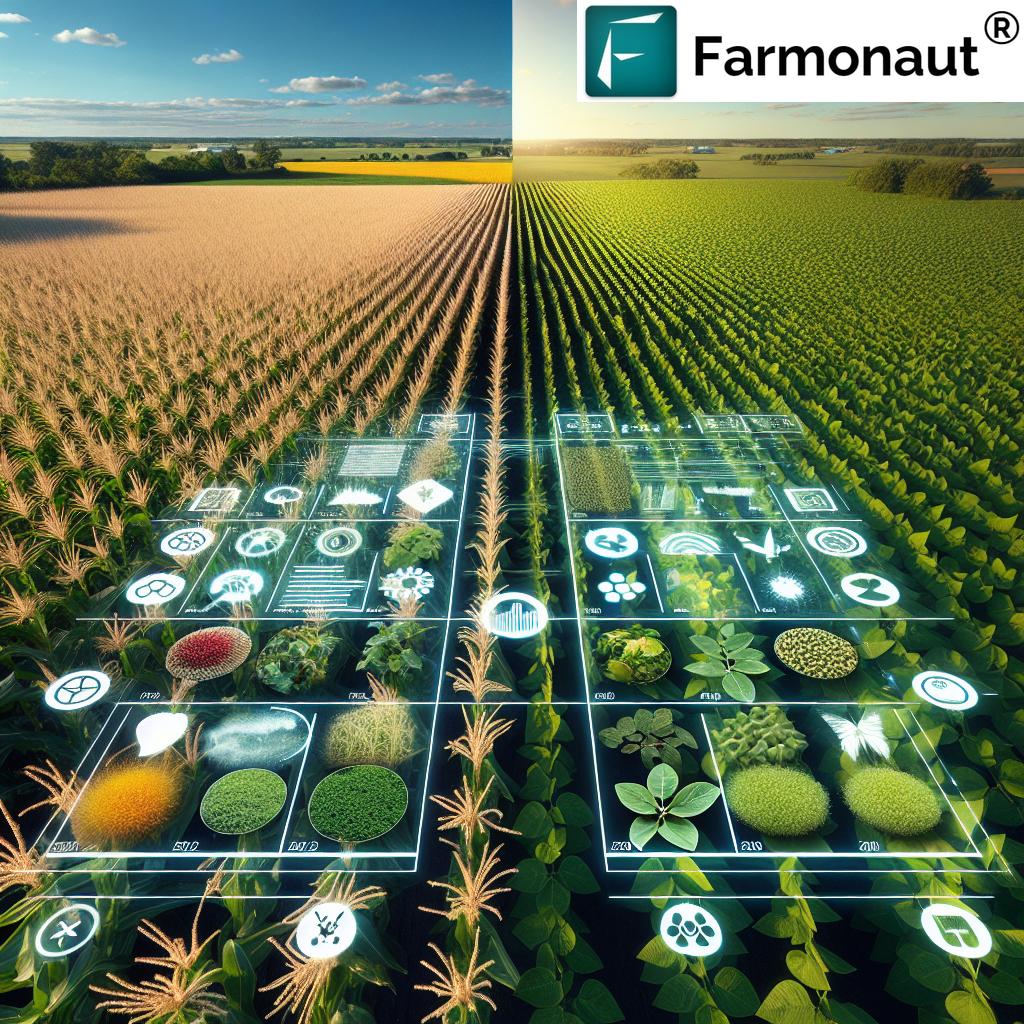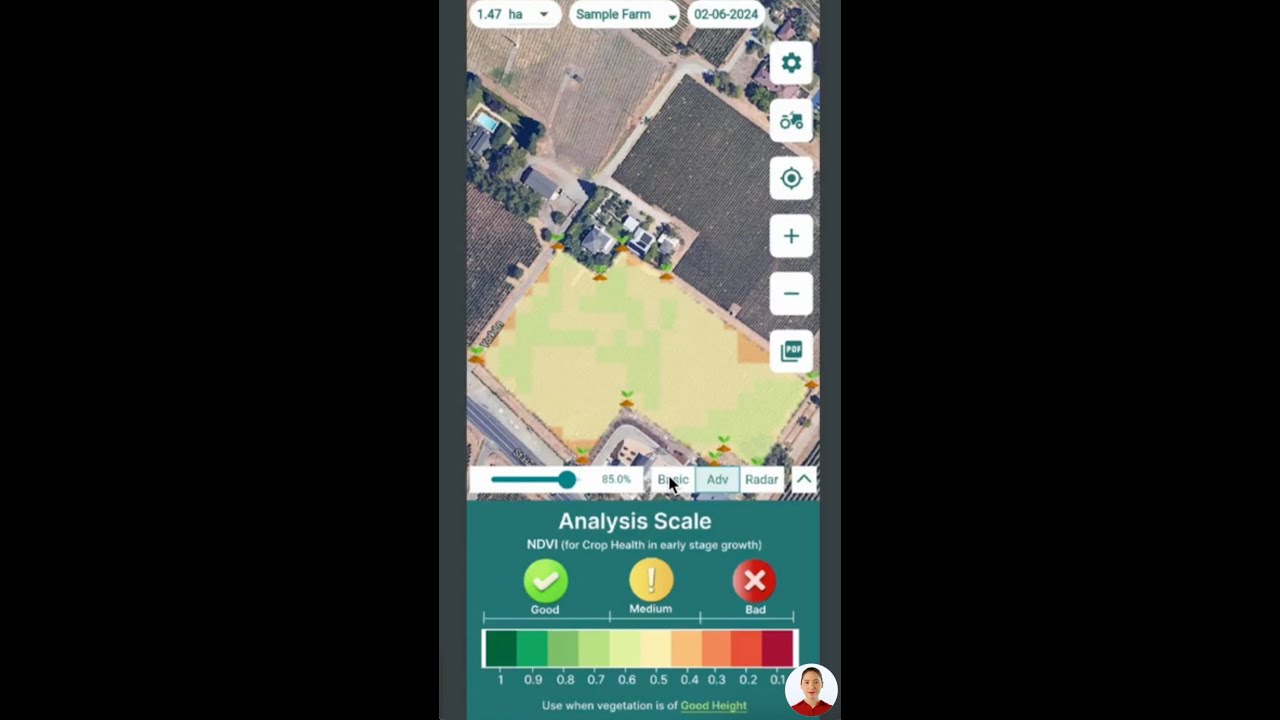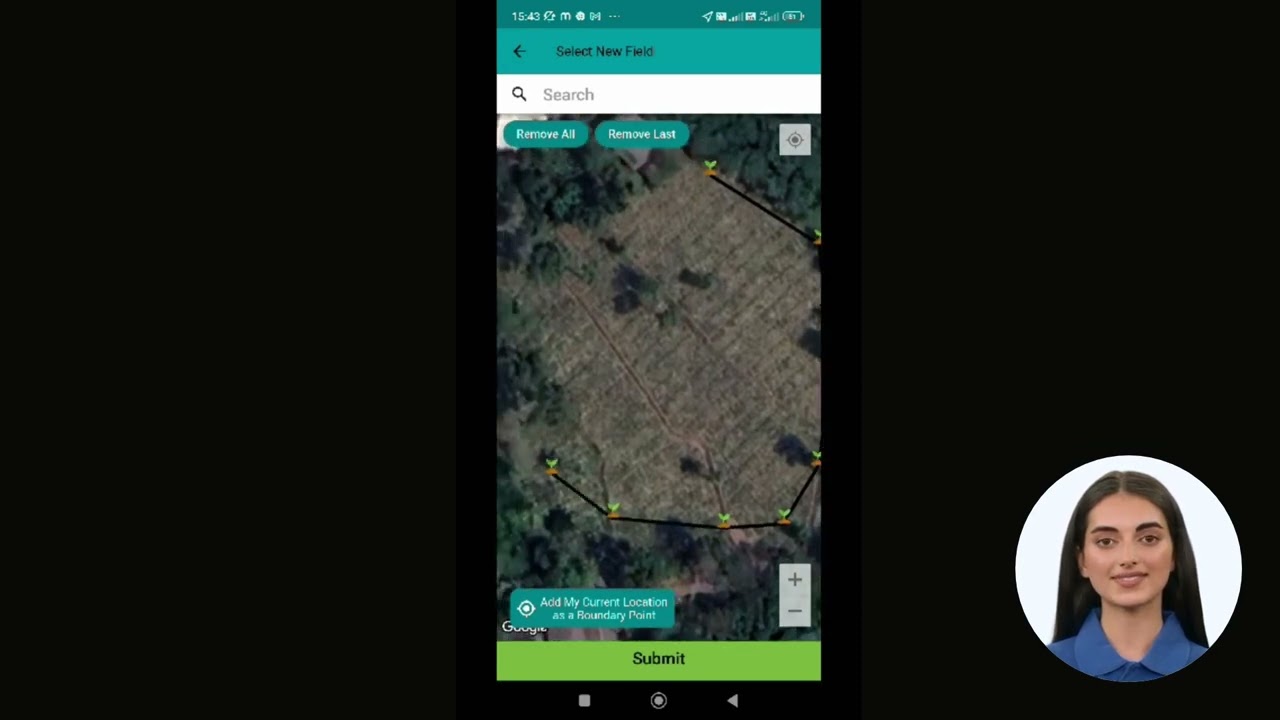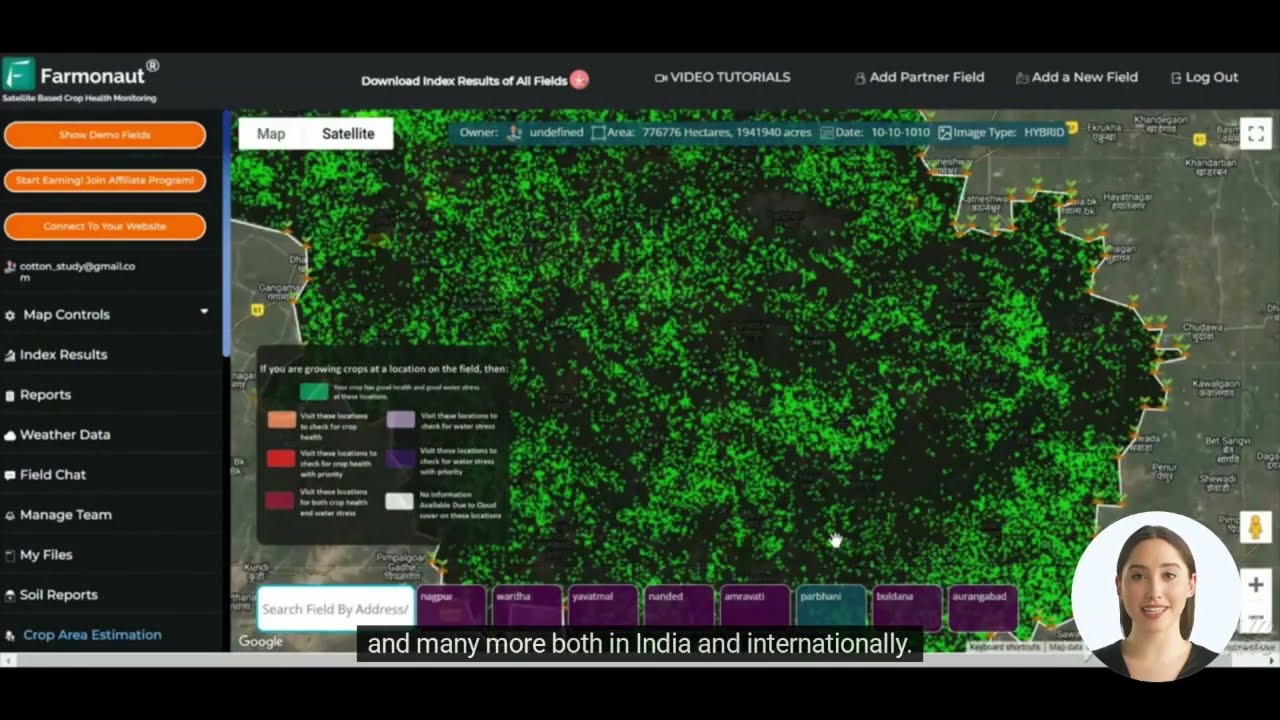Ultimate Corn and Soybean Scouting Guide: Maximize Yields with Farmonaut’s Iowa-Specific Pest Management Calendar
“Corn and soybean farmers in Iowa monitor over 20 different pests and diseases throughout the growing season.”
“Effective scouting can increase crop yields by up to 30% through timely pest and disease management.”

Welcome to our comprehensive guide on corn and soybean scouting in Iowa! As farmers and agronomists, we understand the critical importance of effective crop management in maximizing yields and ensuring a successful growing season. In this blog post, we’ll explore the essential “Corn & Soybean Scouting Calendar” tailored specifically for Iowa’s unique agricultural landscape.
Our goal is to equip you with the knowledge and tools necessary to optimize your crop management strategies throughout the vegetative and reproductive growth stages of both corn and soybeans. From identifying early-season threats like seedcorn maggots to managing late-season challenges such as corn rootworms and various fungal diseases, we’ve got you covered.
Why Scouting Matters: The Foundation of Successful Crop Management
Before we dive into the specifics of our scouting calendar, let’s emphasize why regular and thorough scouting is crucial for Iowa farmers:
- Early Detection: Identifying pest and disease issues early allows for timely intervention, preventing widespread damage.
- Targeted Management: Accurate scouting helps in implementing precise, stage-specific management techniques, reducing unnecessary pesticide use.
- Cost-Effective: By addressing problems before they escalate, you can save on input costs and protect your yield potential.
- Data-Driven Decisions: Regular scouting provides valuable data for making informed agronomic decisions throughout the season and in future years.
To enhance your scouting efforts, we recommend leveraging modern technology like Farmonaut’s satellite-based crop monitoring system. This innovative tool can provide real-time insights into crop health, complementing your on-ground observations.
The Corn and Soybean Scouting Calendar: Your Roadmap to Success
Our scouting calendar is designed to guide you through the entire growing season, from planting to harvest. We’ll break down the key growth stages for both corn and soybeans, highlighting the specific pests and diseases to watch for at each stage. Let’s start with an overview of the calendar structure:
| Crop Stage | Calendar Period | Pests to Scout For | Diseases to Monitor | Scouting Technique | Action Threshold | Management Recommendations |
|---|---|---|---|---|---|---|
| Planting – Early Vegetative | April – May | Seedcorn maggots, Cutworms | Seedling blights | Check seed furrows, monitor emergence | 10% seedling loss | Consider replanting, use seed treatments |
| Mid-Vegetative | June – Early July | Corn rootworms, European corn borer | Goss’s Wilt, Northern Corn Leaf Blight | Examine leaves, check root systems | Varies by pest/disease | Foliar insecticides, crop rotation |
| Reproductive Stages | July – August | Aphids, Japanese beetles | Gray Leaf Spot, Sudden Death Syndrome (Soybeans) | Whole plant inspection, leaf sampling | 250 aphids/plant (soybeans) | Timely fungicide application, resistant varieties |
| Pre-Harvest | September – October | Stink bugs, Bean leaf beetles | Anthracnose Stalk Rot, White Mold | Pod and ear checks, stalk strength tests | 1 stink bug/foot of row | Harvest timing, drying considerations |
Now, let’s delve deeper into each stage, providing detailed insights and management strategies for Iowa’s corn and soybean farmers.
Planting and Early Vegetative Stages (April – May)
The foundation of a successful crop begins at planting. During this critical period, it’s essential to monitor for early-season pests and diseases that can significantly impact stand establishment and early growth.
Key Pests to Watch:
- Seedcorn Maggots: These pests can cause severe damage to newly planted seeds, leading to poor emergence.
- Black Cutworms: Young corn plants are particularly susceptible to cutworm damage, which can result in stand loss.
Diseases to Monitor:
- Seedling Blights: Various fungal pathogens can cause damping-off and root rots in both corn and soybeans.
Scouting Techniques:
Regularly check seed furrows and monitor emergence rates. Look for signs of feeding damage or missing plants. For soybeans, pay close attention to seedling vigor and any signs of damping-off.
Management Strategies:
- Use high-quality, treated seeds to protect against early-season pests and diseases.
- Consider replanting if stand loss exceeds 10-15%.
- Implement cultural practices like crop rotation and proper field preparation to reduce pest pressure.
Farmonaut’s satellite-based crop monitoring can be particularly useful during this stage, helping you identify areas of poor emergence or early stress that may require closer inspection.
Explore Farmonaut’s API for advanced crop monitoring capabilities
Mid-Vegetative Stages (June – Early July)
As corn and soybeans progress through their vegetative stages, new challenges emerge. This period is crucial for establishing strong root systems and healthy leaf canopies.
Key Pests:
- Corn Rootworms: Both larvae and adult beetles can cause significant damage to corn plants.
- European Corn Borer: First-generation larvae can tunnel into corn stalks, causing yield loss.
- Soybean Aphids: Populations can build quickly, leading to stunted growth and reduced yields.
Diseases to Monitor:
- Goss’s Wilt (Corn): Look for long, wavy lesions with freckled appearance on leaves.
- Northern Corn Leaf Blight: Cigar-shaped lesions on leaves can reduce photosynthetic area.
- Bacterial Blight (Soybeans): Angular, water-soaked lesions on leaves can lead to defoliation.
Scouting Techniques:
Implement a systematic scouting pattern, examining leaves, stalks, and root systems. For corn rootworm, consider using sticky traps to monitor adult beetle populations. In soybeans, check the undersides of leaves for aphid colonies.
Management Strategies:
- For corn rootworm, consider soil-applied insecticides or Bt corn hybrids in high-pressure areas.
- Monitor European corn borer moth flights to time insecticide applications effectively.
- In soybeans, use economic thresholds (e.g., 250 aphids per plant) to guide treatment decisions.
- For fungal diseases, consider foliar fungicide applications if disease pressure is high and weather conditions are favorable for disease development.
Farmonaut’s real-time crop health monitoring can help identify areas of stress or potential disease outbreaks before they become visible to the naked eye, allowing for more targeted scouting efforts.
Reproductive Stages (July – August)
As crops enter their reproductive phases, protecting yield potential becomes paramount. This period often sees the emergence of new pest and disease threats.
Key Pests:
- Japanese Beetles: Can cause significant defoliation in both corn and soybeans.
- Corn Earworms: Feed directly on corn ears, reducing grain quality and yield.
- Stink Bugs: Can damage developing soybean pods, affecting seed quality.
Diseases to Monitor:
- Gray Leaf Spot (Corn): Rectangular lesions on leaves can coalesce, reducing photosynthetic area.
- Sudden Death Syndrome (Soybeans): Look for interveinal chlorosis and necrosis on leaves.
- White Mold (Soybeans): Prevalent in dense canopies during cool, wet conditions.
Scouting Techniques:
Conduct whole-plant inspections, focusing on the upper canopy and reproductive structures. In corn, check for silk clipping and ear feeding. In soybeans, examine pods for feeding damage and look for signs of foliar diseases.
Management Strategies:
- Consider foliar insecticide applications for Japanese beetles if defoliation exceeds 30% before bloom or 20% between bloom and pod fill in soybeans.
- For corn earworms, timely insecticide applications during silking can be effective.
- In areas prone to white mold, consider fungicide applications at early bloom in soybeans.
- For both crops, foliar fungicides may be warranted if disease pressure is high and weather conditions are favorable.
Leverage Farmonaut’s advanced satellite imagery to identify areas of potential crop stress or disease outbreaks across your fields, enabling more efficient and targeted scouting efforts.
Pre-Harvest and Harvest Stages (September – October)
As crops approach maturity, focus shifts to preserving yield and grain quality. Late-season pests and diseases can still impact final yields and harvest timing.
Key Pests:
- Bean Leaf Beetles: Late-season feeding on soybean pods can affect seed quality.
- Brown Stink Bugs: Can cause significant damage to developing corn kernels and soybean seeds.
Diseases to Monitor:
- Anthracnose Stalk Rot (Corn): Can lead to lodging and harvest difficulties.
- Frogeye Leaf Spot (Soybeans): Late-season infections can affect seed quality.
- Diplodia Ear Rot (Corn): Can impact grain quality and marketability.
Scouting Techniques:
Conduct thorough field walks, checking for stalk integrity in corn and pod quality in soybeans. Perform the “push test” on corn stalks to assess lodging potential. In soybeans, examine pods for feeding damage and seeds for discoloration or shriveling.
Management Strategies:
- Prioritize harvesting fields with compromised stalk integrity to minimize lodging losses.
- Consider earlier harvest for soybean fields with significant pod feeding or foliar disease pressure.
- Adjust combine settings to minimize harvest losses and damage to low-quality grain.
- Plan for proper grain drying and storage to maintain quality, especially if diseases like ear rots are present.
Farmonaut’s satellite-based crop monitoring can provide valuable insights into field variability and potential problem areas, helping prioritize harvest operations and identify fields that may require special handling or marketing considerations.
Leveraging Technology for Enhanced Scouting
While traditional scouting methods remain invaluable, integrating modern technology can significantly enhance your crop management efforts. Farmonaut’s satellite-based crop monitoring system offers several advantages:
- Early Detection: Identify potential issues before they become visible to the naked eye.
- Comprehensive Coverage: Get a bird’s-eye view of your entire operation, helping prioritize scouting efforts.
- Historical Data: Track field performance over time to inform long-term management decisions.
- Integration with Other Tools: Combine satellite data with weather information and crop models for more accurate predictions and recommendations.
Integrated Pest Management: A Holistic Approach
Throughout the growing season, it’s crucial to adopt an Integrated Pest Management (IPM) approach. This strategy combines various control methods to manage pests and diseases effectively while minimizing environmental impact and preserving beneficial organisms. Key components of IPM include:
- Cultural Practices: Crop rotation, tillage practices, and planting date adjustments can disrupt pest life cycles.
- Biological Control: Encourage natural predators and use biopesticides when appropriate.
- Host Plant Resistance: Select hybrids and varieties with built-in resistance to key pests and diseases.
- Chemical Control: Use pesticides judiciously, based on economic thresholds and IPM principles.
- Monitoring and Record-Keeping: Maintain detailed records of pest populations, treatments, and results to inform future decisions.
By integrating these approaches with the scouting calendar and leveraging technologies like Farmonaut’s crop monitoring system, Iowa farmers can maximize their yields while promoting sustainable agricultural practices.
Conclusion: Empowering Iowa Farmers for Success
Effective crop scouting is the cornerstone of successful corn and soybean production in Iowa. By following this comprehensive scouting calendar and leveraging advanced technologies like Farmonaut’s satellite-based monitoring, farmers can stay ahead of potential issues, make informed management decisions, and optimize their yields.
Remember, the key to successful scouting is consistency and attention to detail. Regular field visits, combined with data-driven insights, will provide the most comprehensive picture of your crop’s health and potential. As you implement these strategies, you’ll not only protect your current season’s yield but also gather valuable information to inform future management decisions.
We encourage you to explore Farmonaut’s suite of tools designed to complement and enhance your scouting efforts. From real-time crop health monitoring to advanced analytics, these resources can help take your farm management to the next level.
Frequently Asked Questions
- How often should I scout my corn and soybean fields?
We recommend scouting at least weekly during critical growth stages, and more frequently if pest pressure is high or weather conditions are favorable for disease development. - Can satellite-based monitoring replace traditional scouting methods?
While satellite monitoring is a powerful tool, it’s best used in conjunction with traditional scouting. Farmonaut’s technology can help identify areas of concern, but on-ground verification is still crucial for accurate diagnosis and treatment decisions. - How can I integrate Farmonaut’s tools into my existing farm management practices?
Farmonaut offers various integration options, including mobile apps, web platforms, and APIs. Start by exploring our user-friendly mobile apps and gradually incorporate more advanced features as you become comfortable with the system. - What are the benefits of using Farmonaut’s satellite-based crop monitoring for scouting?
Farmonaut’s technology provides early detection of crop stress, comprehensive field coverage, historical data analysis, and integration with other agronomic tools. This can lead to more efficient scouting, earlier interventions, and ultimately, higher yields. - How can I get started with Farmonaut’s crop monitoring services?
You can begin by downloading our mobile app or signing up for a web account. We offer various subscription options to suit different farm sizes and needs. Explore our pricing table below for more information.
By implementing this comprehensive scouting guide and leveraging Farmonaut’s advanced technology, you’ll be well-equipped to tackle the challenges of corn and soybean production in Iowa. Remember, successful crop management is an ongoing process of observation, analysis, and informed decision-making. Here’s to a bountiful harvest and continued success in your farming endeavors!





















